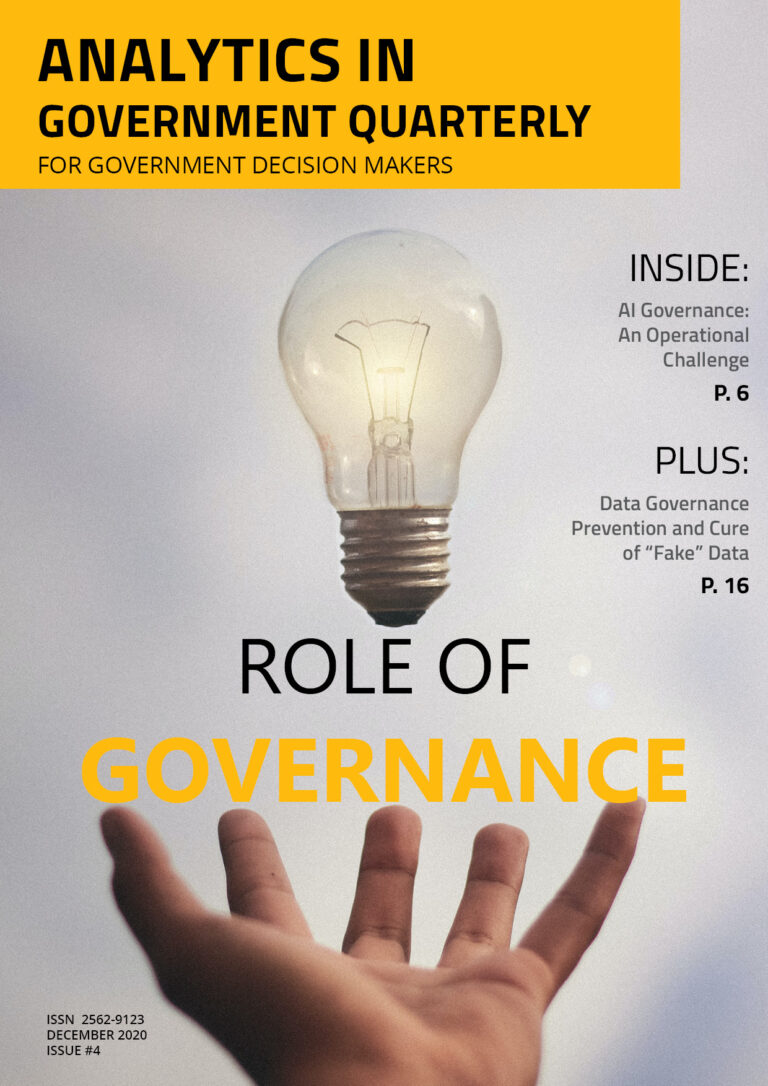POINT OF VIEW
Governing Analytics to Promote Diversity and Inclusion
How important is it to consider diversity & inclusion when it comes to analytics? An article from McKinsey shows that “Companies in the top quartile for gender diversity outperform their competitors by 15% and those in the top quartile for ethnic diversity outperform their competitors by 35%”
By Tara Holland

How important is it to consider diversity & inclusion when it comes to analytics? How important is diversity and inclusion in society? The charter of rights states that “Every individual is equal before and under the law and has the right to the equal protection and equal benefit of the law …, without discrimination based on race, national or ethnic origin, colour, religion, sex, age or mental or physical disability”. As governments modernize the delivery of services to their citizens through digital transformation efforts, analytics will be at the heart of the decision making.
Decision-making about how the digital solutions are designed and using artificial intelligence, more and more of the day-to-day decisions in government will also be driven by analytics. The protections offered by the charter of rights is not a standard to live by but more so represents the minimum requirements that need to be met, and despite these clear instructions from the charter there is still overwhelming systemic inequality. From a moral and ethical perspective, we owe it to society to consider and include the perspectives of all individuals as we build analytic solutions, and to treat individual differences as assets rather than outliers.
The Diversity & Inclusion Imperative
If not for the betterment of society or ethical and moral reason, how about for a sound business decision? Research has consistently shown the business benefits of diversity. An article from McKinsey shows that “Companies in the top quartile for gender diversity outperform their competitors by 15% and those in the top quartile for ethnic diversity outperform their competitors by 35%”.[1] These numbers cannot be ignored and quantify the importance of diversity in the workplace; it is in everyone’s best interest that policies and bodies are put in place to move in this direction. Furthermore, Canadian laws are requiring companies to be transparent and answer for a lack of diversity as summarized in this Library of Congress Article “Canada: Higher Standards Set for Workplace Diversity”[2] and the federal government is ensuring this with Bill C-25 [3] in effect as of January 1, 2020. Government agencies must hold themselves to the same or higher standard.
A Starting Point for Analytics Governance
How do we approach diversity and inclusion in the field of analytics? We start by challenging the status quo. Are we solving the right problem? Do we have the right data? What is the limitation of our findings? Are we having the right conversations? When it comes to the governance of analytics, the processes and decision makers must assume the answer to these questions is ‘no’ and the next step after acknowledging and accepting this assumption is to address these issues. We must question things we assumed to be fact; things that may have seemed to be absolute in the past.
Unique Challenges: Culture, Methods, Data
The field of analytics must address and overcome some inherent challenges to build diverse and inclusive solutions. The disciplines that lead individuals toward a career in analytics and the skills, training and communication tools are built on a premise of objective quantification. This creates a culture in the field of analytics which is based on “finding the right answer” and “trusting the data”, which in a perfect world, should be within reason. However, when problems are complex, the parameters set by analytical techniques, laws, regulations and cultural norms are often too limited or turn out to be exclusive, therefore missing certain perspectives and considerations. This can have serious impacts on the results. During a recent webinar on “Building a Diverse and Inclusive Government with Analytics”, one of the panelists shared an example of how “A survey conducted came back with strange results because the questions though translated properly had different than intended meaning in varying cultures which in the end resulted in publishing misleading results and ultimately the retraction acknowledging the data was incorrect”. Even with the best intention, mistakes and missteps will happen along the way, but we must learn from these mistakes and do our best mitigate them moving forward.
The field of analytics serves the purpose of simplification, taking vast amounts of data and seeking to categorize and define, and has developed methods to do just that. When it comes to diversity, one of the most miscommunicated, misused and misclassified terms is the “average”. When it comes to human experiences there is no such thing as an average human and creating a target or measurement to this end should not be an analytic endeavour. Historically it has also been shown that systems in our society are built around the concept of “average”. This has proven to marginalize many groups as discussed in this article[4] from Harvard Graduate School of Education. As we are in the middle of a digital revolution, similar in scale to the industrial revolution, we cannot afford to make the same mistakes and further marginalize the groups already suffering.
How do we Address the Challenges?
Some recognized strategies to proactively address these challenges are having diverse teams, employing a diverse set of analytic techniques, and a governance structure that intentionally looks for gaps.
Diversity is a strength and a strategy of trying to get individuals to fit a certain mold diminishes that strength. The traditional method of hiring for specific technical skillsets needs to be examined. Skills can be taught, but there are qualities, perspectives and characteristics that can only be acquired through diverse hiring. Lack of diversity in a team was the acknowledged factor in a well-publicized misstep by Google.[5] After launching the YouTube for iOS, the functionality did not work for left-handed people simply because there was no one on the development or testing team who was left-handed. This example is amusing but enlightening. Given the multiple facets of diversity and the fact that most aspects of diversity are not as visible as being left-handed, hiring and staffing practices must intentionally seek out diversity. Attracting different mindsets and disciplines to the field of analytics and broadening the perspectives of teams through continued learning is a key to limiting mistakes. We should use analytics to access what talents we have and to maximize those skillsets rather than to force individuals and teams to fit an “established norm”.
Analytics teams that employ a broad set of disciplines and techniques are also more likely to spot the gaps and unintended bias. This may take a turn to different strategies such as mixed methods and greater emphasis on the qualitative and interpretative side of data. Sophisticated machine learning methods are capable of modelling complex scenarios, but we as decision makers and governors of analytics must provide these algorithms with complete and inclusive data. In order to do so we must have a diverse team, mindset and culture.
Individual analytics professionals must be willing to have uncomfortable discussions that question the validity of our assumptions and results. A governance body that has D/I built into its terms of reference will have the authority and responsibility to ensure these discussions take place…..If we continue to address diversity and inclusion gaps head on, there will come a point where these become a key part of our analytic strategy and will no longer feel uncomfortable. We must acknowledge that our perceptions and assumptions about specific groups is typically wrong. If we put in place governance practices that challenge our teams, if we learn basic skills to recognize and embrace diversity, and if we build on that knowledge over time, the solutions we build will be more inclusive. To make a difference it is important to feel some discomfort. If, as government leaders and analytics professionals, we aren’t feeling the growing pains or making some mistakes, it is likely that nothing is changing, and we should re-examine our approach.
- Vivian Hunt, Dennis Layton, and Sara Prince (2015), Why diversity matters, McKinsey Company
- Tariq Ahmad, 2019, Canada: Higher Standards Set for Workplace Diversity
- Parliament of Canada, 2018, BILL C-25
- Lory Hough, 2015, Beyond Average
- Sean Buckley, 2014, Unconscious bias is why we don’t have a diverse workplace, says Google
About The Author

Tara Holland
As an industry specialist in the Global Government Practice, Tara brings best practice and proven solutions to government customers and partners around the world. Her role is to connect and collaborate with the leaders from the industry and across business units with in SAS. Based in Canada, Tara has been with SAS for over 20 years focused on supporting public sector customers. Her passion is in bridging the gap between business needs and technology solutions and enabling public sector organizations to deliver on the value of data. Prior to joining SAS, Tara led the Data Mining team at Canada Revenue Agency and lived the real-life challenges faced by organizations wanting to be more data and analytics driven.

